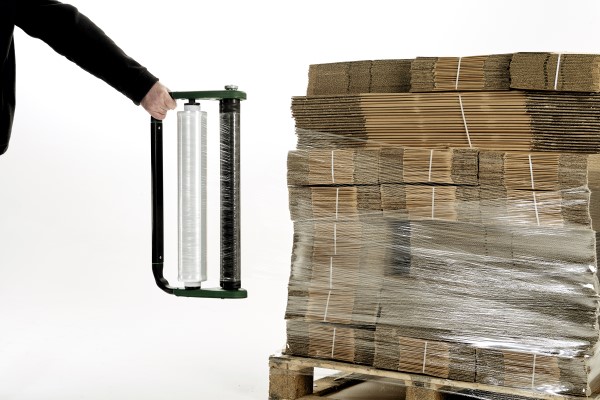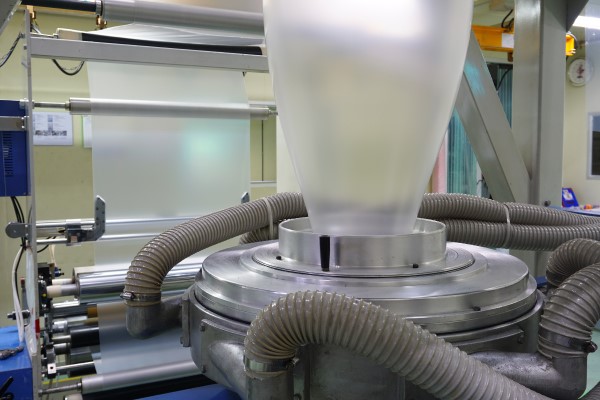Kite blog
What is the Difference Between Blown and Cast Pallet Wrap?
Ever wondered what makes pallet wrap so effective at securing your valuable goods during transit? The secret lies in understanding the different types of films available, including blown and cast pallet wraps.
Pallet wrap is an industrial packaging solution that secures pallets for storage and transportation. By wrapping around a pallet, it stabilises the load and protects your goods against damage and loss.
While you might be aware of the various types of films available – differing in colour, strength, application, core type and more – did you know there are also distinct blown and cast options?
The key difference between blown and cast films lies in their manufacturing process which impacts their usability and cost.

How is cast stretch wrap made?
Extrusion
The process begins with LLDPE (Linear Low-Density Polyethylene) pellets, which are fed into an extruder. The extruder melts the pellets and forces the molten plastic through a narrow slot (also known as a flat die), forming a thin sheet of plastic.
Casting
The molten plastic is then cast onto a chilled roller, where it cools and hardens quickly. This rapid cooling process gives the film its clarity and strength.
Stretching
After cooling, the film passes through a series of rollers that stretch it in multiple directions. This process enhances the film's strength and elasticity, allowing it to stretch and conform tightly around the pallet load.
Winding
Once the film reaches the desired thickness, it is wound onto large rolls. These rolls are then slit into smaller rolls, ready for use.
This is the cast extrusion process.
How is blown stretch wrap made?
Extrusion
The process begins with LLDPE (Linear Low-Density Polyethylene) pellets, which are melted by an extruder and pushed through a circular die. This forms a tube-shaped film.
Inflation
The key difference between cast and blown film production is the inflation process. Air is blown into the centre of the tube, inflating it into a large, vertical bubble.
Cooling and Stretching
As the bubble inflates, it cools. The machine blows air onto the surface of the film, which cools it more slowly than cast film, giving blown film its tough and durable structure. As the bubble rises, the film stretches both vertically and horizontally, improving its strength and flexibility.
Winding
Rollers collapse and flatten the film into a double layer, winding them onto large rolls. Finally, the rolls are cut into smaller rolls and ready for use.
This is the blown extrusion process.
In essence, while both processes involve melting and shaping LLDPE pellets, the key differences in cooling and stretching techniques result in distinct properties for each type of film.

Benefits of blown vs. cast stretch wrap
Blown stretch film:
- Superior Stretch and Strength: Better at handling heavier loads due to its enhanced resilience.
- Greater Tear and Puncture Resistance: Higher thickness variation due to inflation provides extra durability.
- High 2-Sided Cling: Offers strong adhesion on both sides, unless using Kite's patented machine film.
- Reduced Clarity: Not as clear as cast film, which can make reading and scanning more challenging.
- Noise Level: Produces a high-volume sound when unrolled, which might be a consideration in quieter environments.
Cast stretch film:
- Lower Strength and Stretch: More suitable for lighter applications.
- Ease of Stretching: High amount of Metallocene* (see below) allows for easy stretching, but improper application can cause shifting.
- Single-Sided Cling: Naturally adheres on one side, preventing it from sticking to adjacent pallets.
- High Clarity: Perfectly clear with lower haze, making reading and scanning much easier.
- Quiet Operation: Unwinds quietly from the reel, ideal for noise-sensitive settings.
*What is Metallocene?
Metallocene is a chemical compound used as a catalyst in plastic production. It makes the plastic film stronger, clearer, and stretchier which improves its performance in wrapping and protecting items.
Blown and cast stretch films each offer distinct advantages, making them suitable for different applications.
Applications
| Feature | Blown Film | Cast Film |
| Strength | High | Moderate |
| Load Type | Suitable for heavy, sharp, irregular loads | Best for light, regular loads |
| Clarity | Less clear | Crystal clear |
| Noise | Noisy during unwinding | Quiet |
A construction company may prefer blown film for its durability in wrapping heavy and irregularly shaped building materials. Meanwhile businesses in retail and ecommerce will prefer to use cast film as they need clear visibility for product presentation and scanning barcodes.
We stock hand and machine stretch films in both cast and blown varieties.
Blown & cast films at Kite Packaging
Interested in exploring our selection of pallet wraps? Discover our full range of blown and cast pallet wraps today and find the perfect solution for your packaging needs.
We have a range of cast and blown hand pallet wraps available, including pre-stretch films and films containing 30% recycled content.
Our machine range is only available in cast.
